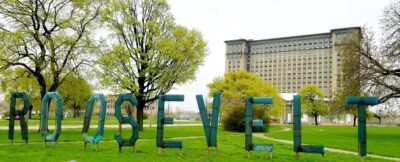Detroit is midstride in its great comeback, emerging like a phoenix in full burn. In a city which has suffered so much loss, not only are community leaders and private investors acting to salvage what remains, but they are making the city whole again by knitting together gaps with new infill. Big impacts have been directed to the downtown core, yet there’s still much to be done at the neighborhood level.
One of the instruments of Detroit’s success was established during the economic recovery, with an unorthodox approach to building preservation and reuse. In 2013, City of Detroit and the Detroit Landbank Authority (DLBA) received an allocation from the Hardest Hit Fund. Working with an army of volunteers from the Michigan Historic Preservation Network and Preservation Detroit, along with homegrown tech experts from Data Driven Detroit (D3) and Loveland Technologies, they created the Detroit Blight Task Force. Out of this creative partnership, Blexting -short for blight texting- was born.
Blexting created a survey of the condition of nearly every property in the city of Detroit. The results were informed recommendations for the demolition of thousands of properties by DLBA. Instead of blindly pushing through blight elimination dollars, Detroit’s leaders used a more sophisticated approach supported by photos and existing conditions data directly uploaded to the survey. By documenting and evaluating a substantial portion of the city’s building stock, the taskforce effectively put assets into a building savings account for when the market ripened for rebirth.
Less than a decade later, Detroit is now activating those saved assets. Neighborhood-level community plans and new developments contain a mixture of building rehab, adaptive reuse, and new infill construction. Sections of the city which had not seen new work in decades are now receiving reinvestment. And it’s far from done.
Detroit is in many ways unique. Yet in other ways, such as scarcity of resources, lost taxable value, and declined population, it mirrors the disinvestment felt by many Michigan towns. Here are lessons learned for Michigan’s aging building stock.
Strategize & Combine Tactics
The decisions cities make today will shape the reality of their future. Cities need to articulate a consensus vision of who they are and who they want to be. Immediate tactics are site inventory, zoning reform, and the choice of target sites for catalytic reinvestment. Doubling down on existing buildings – both historic gems and simply older sites – and development of vacant lots in core city centers can also help cities respond to increasing interest in lessening environmental impact and improving infrastructure resiliency.
Michigan residents are choosing increasingly to live, work, and be in places of authentic texture. And because energy use is an increasingly important issue, they often want it connected to transit. The Q Line on Woodward is one way that Detroit is concentrating effort along an existing corridor, building in walkable transit-oriented development amid the streetcar suburbs of the last century.
Explicitly Advocate for Diversity
Only 8 percent of National Register sites and 3 percent of our National Historic Landmarks represent people of color, women, or members of the LGBTQ community. As stated by National Main Street CEO Patrice Frey in a recent City Lab article, “The preservation movement is also struggling to tell the full American story.”
Cities must build an authentic local vision by asking their residents to help with asset inventory. Get on the ground and engage in conversations with those who live there. Record what defines the place to avoid sacrificing cultural identity.
Detroit is owning the gaps in its recorded history and they’re doing something about it. Through neighborhood planning efforts, the city is backfilling a broad range of under-told histories which are more reflective of all residents. They’re doing this through a pilot event that brings together several departments to engage with local preservation stakeholders. Tiffany Rakotz, a Preservation Specialist at the City of Detroit, says this dialogue will focus on thematic topics that impact local preservation efforts during this period of recovery and growth.
Broaden the Concept of ‘Preservation’ to Plan for Attainable Housing
According to recent discussions at the Urban Land Institute’s spring meeting in Detroit, households are now choosing smaller homes in favor of proximity to parks, walkability to shops, and employment. The magical formula here also includes the key calculation of what people can actually afford.
In considering how to rehab Michigan’s aging housing stock and accommodate gaps with new construction infills, communities must choose a diversity of options instead of one single family housing solution. Prior to standardized zoning, historic neighborhoods had small scale commercial next to single-family homes mixed with multi-unit splits, carriage houses turned into apartments, row houses, and duplexes intentionally built next to single units.
By easing zoning restrictions and allowing these natural adaptations to take place by-right in the code, we can not only legalize what has happened in neighborhoods for decades, we can also encourage reinvestment in those same neighborhoods in new and creative ways.
In choosing to allow for a mixture of building types for rebuilding neighborhoods, cities can also communicate that attainable quality for many income bands does not equal luxury housing. Cities also need to develop alternative financing options so people who want to fix up their aging building stock – either in incremental multi-unit development or single-family rehab – can access the funds to accomplish the work.
Tempering community engagement with realistic expectations is key. In Detroit, members of the community are being actively engaged in “preserving local history, and in creating a vision for the future,” says Rakotz. “I think it is important for the citizens of Detroit to recognize what resources the City is able to provide and for us as public servants to understand what those citizens want.”
